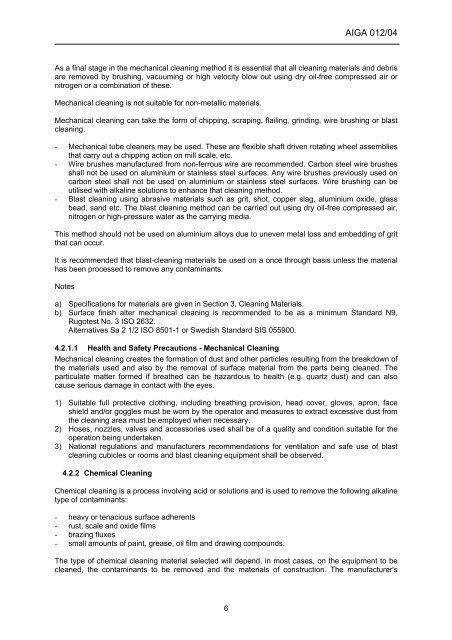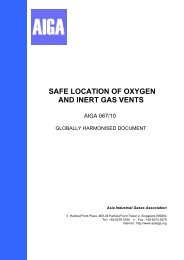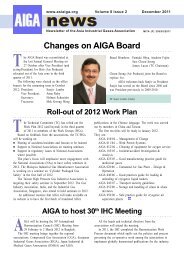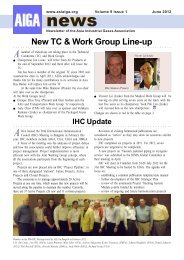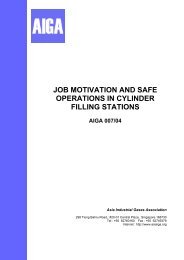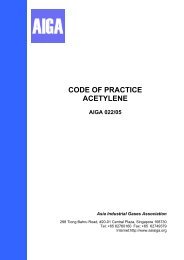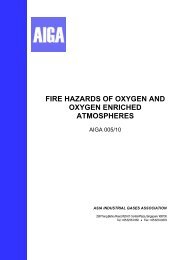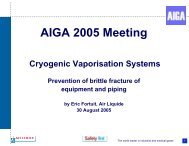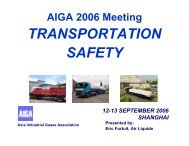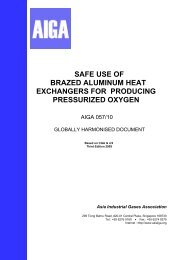CLEANING OF EQUIPMENT FOR OXYGEN SERVICE - AIGA
CLEANING OF EQUIPMENT FOR OXYGEN SERVICE - AIGA
CLEANING OF EQUIPMENT FOR OXYGEN SERVICE - AIGA
You also want an ePaper? Increase the reach of your titles
YUMPU automatically turns print PDFs into web optimized ePapers that Google loves.
6<br />
<strong>AIGA</strong> 012/04<br />
As a final stage in the mechanical cleaning method it is essential that all cleaning materials and debris<br />
are removed by brushing, vacuuming or high velocity blow out using dry oil-free compressed air or<br />
nitrogen or a combination of these.<br />
Mechanical cleaning is not suitable for non-metallic materials.<br />
Mechanical cleaning can take the form of chipping, scraping, flailing, grinding, wire brushing or blast<br />
cleaning.<br />
- Mechanical tube cleaners may be used. These are flexible shaft driven rotating wheel assemblies<br />
that carry out a chipping action on mill scale, etc.<br />
- Wire brushes manufactured from non-ferrous wire are recommended. Carbon steel wire brushes<br />
shall not be used on aluminium or stainless steel surfaces. Any wire brushes previously used on<br />
carbon steel shall not be used on aluminium or stainless steel surfaces. Wire brushing can be<br />
utilised with alkaline solutions to enhance that cleaning method.<br />
- Blast cleaning using abrasive materials such as grit, shot, copper slag, aluminium oxide, glass<br />
bead, sand etc. The blast cleaning method can be carried out using dry oil-free compressed air,<br />
nitrogen or high-pressure water as the carrying media.<br />
This method should not be used on aluminium alloys due to uneven metal loss and embedding of grit<br />
that can occur.<br />
It is recommended that blast-cleaning materials be used on a once through basis unless the material<br />
has been processed to remove any contaminants.<br />
Notes<br />
a) Specifications for materials are given in Section 3, Cleaning Materials.<br />
b) Surface finish alter mechanical cleaning is recommended to be as a minimum Standard N9,<br />
Rugotest No. 3 ISO 2632.<br />
Alternatives Sa 2 1/2 ISO 8501-1 or Swedish Standard SIS 055900.<br />
4.2.1.1 Health and Safety Precautions - Mechanical Cleaning<br />
Mechanical cleaning creates the formation of dust and other particles resulting from the breakdown of<br />
the materials used and also by the removal of surface material from the parts being cleaned. The<br />
particulate matter formed if breathed can be hazardous to health (e.g. quartz dust) and can also<br />
cause serious damage in contact with the eyes.<br />
1) Suitable full protective clothing, including breathing provision, head cover, gloves, apron, face<br />
shield and/or goggles must be worn by the operator and measures to extract excessive dust from<br />
the cleaning area must be employed when necessary.<br />
2) Hoses, nozzles, valves and accessories used shall be of a quality and condition suitable for the<br />
operation being undertaken.<br />
3) National regulations and manufacturers recommendations for ventilation and safe use of blast<br />
cleaning cubicles or rooms and blast cleaning equipment shall be observed.<br />
4.2.2 Chemical Cleaning<br />
Chemical cleaning is a process involving acid or solutions and is used to remove the following alkaline<br />
type of contaminants:<br />
- heavy or tenacious surface adherents<br />
- rust, scale and oxide films<br />
- brazing fluxes<br />
- small amounts of paint, grease, oil film and drawing compounds.<br />
The type of chemical cleaning material selected will depend, in most cases, on the equipment to be<br />
cleaned, the contaminants to be removed and the materials of construction. The manufacturer's


